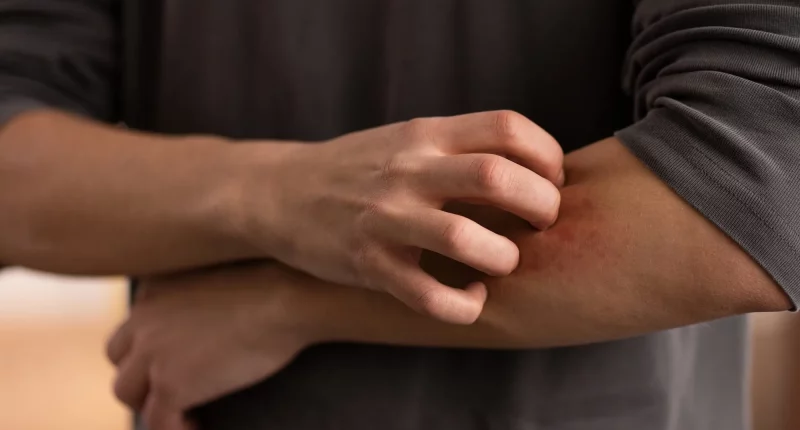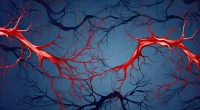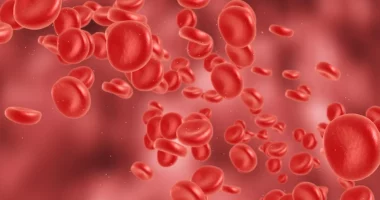Actinic keratosis, also called solar keratosis, is a skin growth that can turn into cancer if not treated. It happens because of too much contact to UV light from the sun.
These growths often show up in clusters and are most common on parts of the body that get a lot of sun, like the face, hands, and arms.
Since actinic keratosis can become cancerous, it’s important for doctors to keep an eye on it and treat it when necessary.
This article will explain what causes actinic keratosis, its symptoms, and how it can be treated.
What is Actinic Keratosis?
Actinic keratosis is a bumpy, rough spot that appears on the skin. These spots often show up in areas that get a lot of sun, like:
- The face
- The ears
- The neck
- The scalp
- The backs of the hands
- The back of the forearms
- The shoulders
Actinic keratoses growth slowly over many years and are most common in people over 50. In the United States, over 58 million population have affected at least one with actinic keratosis.
The size of these patches can vary from very small to over an inch across. They can also be different colors, ranging from light to dark. While most people don’t have other symptoms, some might feel tenderness, itching, or a stinging sensation.
Having actinic keratosis increases the chance of skin cancer, particularly squamous cell carcinoma, if not treated.
Appearance
Recognizing actinic keratosis early can help you seek medical advice quickly. While they can look different from person to person, common features include:
- Raised, discolored areas on the skin
- Rough bumps
- Several scaly spots that resemble acne
- Crusty patches
By knowing what to look for, you can identify actinic keratosis and consult a doctor for proper treatment.
Causes
Actinic keratoses happen because too much exposure to UV light damages the skin cells. Unlike sunburn, which shows up right after being in the sun too long, actinic keratoses take many years to develop from regular sun exposure.
Risk Factors
Anyone can get actinic keratoses over time, but some people are more likely to develop them. Factors that increase the risk include:
- Being 50 years old or older
- Having a history of sunburns or spending a lot of time in the sun
- Living in a sunny area
- Utilizing tanning beds
- Having had actinic keratosis before
- Having light-coloured eyes or hair
- Getting sunburned easily
These factors can make your skin more vulnerable to damage from UV light, increasing the chance of developing actinic keratoses.
Diagnosis
Often, people notice a small, rough patch of skin that might be actinic keratosis. It’s important to see a doctor right away when you notice any new or unusual bumps or changes in your skin. Early detection can help address any potential problems sooner.
A healthcare provider or dermatologist can usually diagnose actinic keratosis just by looking at it. If they’re not sure, they might take a small sample of the skin (called a biopsy) and send it to a lab for testing. This helps confirm if it’s actinic keratosis or something else.
Prevention
Preventing actinic keratosis mainly involves making some lifestyle modifications to protect your skin from UV light. Here are some simple steps you can take:
- Wear Sunscreen Daily: Use sunscreen every day, even when it’s cloudy, to protect your skin from UV rays.
- Avoid too much contacti with sun light: Try to stay out of the sun, especially during peak hours (10 a.m. to 4 p.m.), when the UV rays are the strongest.
- Cover Up: When you are in direct sunlight, wear protective clothing like hats, long sleeves, and sunglasses to shield your skin.
Remember, UV light from any source can cause actinic keratosis, as well as indoor tanning beds. Avoid using these to reduce your risk.
Regularly check your skin for any new or unusual spots or changes. If you notice anything, contact a healthcare provider right away. Early detection and treatment are key to managing actinic keratosis effectively.
Treatment
Doctors have several ways to treat actinic keratosis, which is important to prevent it from turning into skin cancer. The treatment options might include:
- Medication: Creams or gels that you apply to your skin to help remove the rough patches.
- Surgery: Procedures to remove the patches, such as freezing them off with liquid nitrogen (cryotherapy) or cutting them out (excision).
- Photodynamic Therapy: This treatment uses a special medicine that makes the affected skin cells sensitive to light. Then, a special light is used to destroy these cells.
The treatment plan depends on what the patient prefers and how severe their symptoms are. Following the treatment plan closely is very important for the best results.
Medication
For widespread cases of actinic keratosis, doctors might suggest using special creams or ointments. Some of these medicated creams include:
- 5-Fluorouracil Cream
- Diclofenac Sodium Gel
- Imiquimod Cream
Surgery
If someone only has a few patches or spots, doctors might recommend get rid them through minor surgery. There are different surgical procedures for actinic keratosis:
- Cryotherapy: Liquid nitrogen is applied to the skin, making the affected area peel and blister. As the skin cures, the rough patches fall off, leaving behind new, healthy skin.
- Curettage: This involves scraping off the injured skin cells using a special tool called a curette.
- Electrosurgery: After curettage, electrosurgery may be done. A pen-shaped device is used to damage any left abnormal tissue and stop bleeding.
- Chemical Peels: A chemical is applied to the affected area to remove the upper layer of skin.
- Photodynamic Therapy: A special solution is applied to the skin, making it sensitive to light. Then, an artificial light is used to activate the solution, killing the damaged cells.
These treatments help remove actinic keratosis and prevent it from turning into skin cancer.
Outlook
If someone has actinic keratosis and doesn’t get proper treatment, they could develop skin cancer.
The sooner a doctor finds and treats actinic keratosis, the less likely it is to turn into cancer.
After treatment, people might need to see a dermatologist regularly. Usually, it’s once a year, but if someone’s immune system is weak, they might need more frequent check-ups.
Summary
Actinic keratosis is a type of dysplasias growth on the skin caused by damage from contact with the UV. These growths can look like scales, bumps, or rough, crusty patches on the skin.
Millions of individuals in the U.S. have actinic keratosis, especially older people. Early treatment and diagnosis can stop it from becoming skin cancer. So, it’s important to get any unusual skin changes checked by a doctor.
External Links








